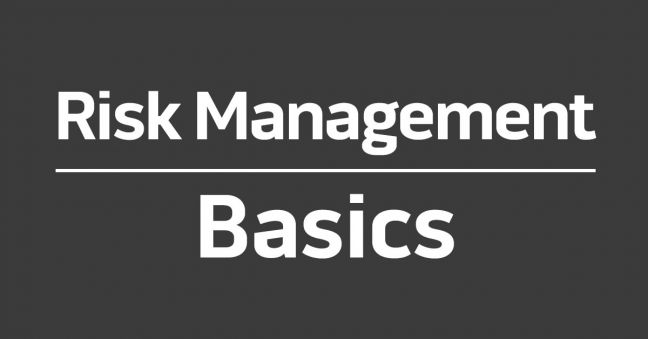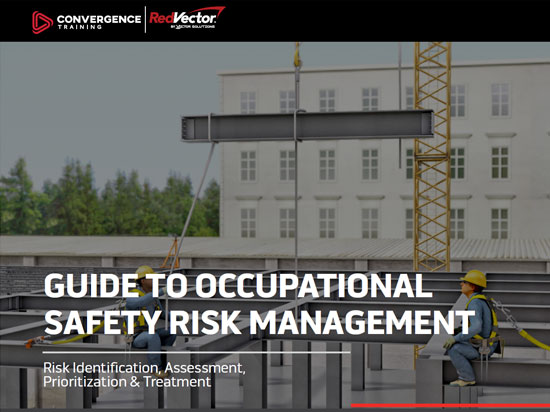
In this installment of our Risk Management Basics series, we’re going to learn about risk treatment.
If you’ve been reading our Risk Management Basics series, you know we addressed the Three Stages of Risk Assessment in a recent article. Risk Treatment is often the next step in the risk management process after risk assessment.
We’ll be writing more in this Risk Management Basics series, so if you’re liking it stay tuned. Plus, feel free to use the comments section at the bottom to ask risk-related questions or to suggest risk-related article topics for the series.
And finally, even though an organization can and should use risk management for all of its objectives, we want you to know we’ve got a free downloadable guide to using Risk Management for Occupational Safety and Health Management at the bottom of this article for you.
- Learning Management Systems
- Online Workforce Training Courses
- Incident Management Software
- Mobile Training Apps
What Is Risk Treatment?
Risk treatment follows risk analysis in the risk management process and its goal is to select one or more option for addressing the risk and then implementing the option(s).
Risk treatment involves a five-step, iterative process that’s quite similar to the common PDCA cycle for continuous improvement (click that link for a free PDCA cycle infographic). The five steps of the risk treatment process are:
- Brainstorming and selecting one or more options for risk treatment
- Planning and then implementing the risk treatment(s) selected
- Evaluating the effectiveness of the risk treatment
- Determining if the remaining risk after the implementation of the risk treatment is acceptable (or not)
- Taking further risk treatment actions if you determine that the remaining risk is not acceptable
Let’s take a closer look at each aspect of risk treatment in the sections below.
Brainstorming and Selecting Risk Treatment Options
Your risk treatment option(s) may lead you in any of the following directions:
- Discontinue or don’t start the action that gave rise to the risk (meaning you avoid the risk)
- Removing the risk source
- Changing the likelihood of the event associated with the risk
- Changing the consequences of the event associated with the risk
- Sharing the risk (such as by buying insurance)
- Choosing to keep the risk
- Choosing to take or increase to try to achieve an opportunity
Selecting the risk treatment option should include a consideration of factors beyond merely economic considerations and should always be made with the organization’s objectives, risk criteria, and resources in mind. When selecting a risk treatment option, balance the benefits of implementing the option and making progress toward achieving the objective against all costs of the risk treatment implementation.
Keep in mind to consider the values, perceptions, and involvement of all stakeholders when selecting a risk treatment option. In addition, you’ll want to select the best way to communicate and consult with them before, during, and after risk treatment.
Remember that risk treatments may not always produce the consequences intended, and may even create unintended consequences and/or new risks that you’ll need to manage. That’s why you’ll want to monitor and review your risk treatment during the evaluation phase mentioned below.
Planning and Implementing Risk Treatments
Next, create a plan for implementing the risk treatment. The risk treatment plan spells out how the risk treatment will be implemented. This helps all involved have the same understanding and helps you measure progress toward implementation.
Your risk treatment plan should include:
- The reason for selecting the risk treatment option
- The benefit(s) you expect from implementing the risk treatment option
- The people accountable and responsible for approving the plan
- The people accountable and responsible for implementing the plan
- The actions involved in implementing the risk treatment
- All resources required for implementation, including contingencies
- The performance measures to be monitored and evaluated
- Constraints
- The plans for monitoring and reporting
- The schedule/time table/deadlines
Once you’ve created your plan for implementing the risk treatment, follow the plan and implement the treatment.
Evaluating the Effectiveness of Implemented Risk Treatments
Once you’ve implemented your risk treatment(s), you’ll want to monitor and review them to evaluate their effectiveness. Remember, this is something you should have prepared to do when creating your risk treatment plan, as described above.
Monitor and review your risk treatments at all points of the process. Be sure to clearly assign this responsibility so it’s carried out as necessary (again, see your risk treatment plan).
If your risk treatment is working as planned (or better), great. Stay the course. If it’s not working as well as planned, you may want to reconsider your risk treatment and/or add another risk treatment.
Don’t forget about our free PDCA cycle infographic, which is a nice reminder of the importance of evaluating the effectiveness of a change.
Recording and Reporting on Risk Treatments
Always document all phases of the risk management process, including of course risk treatment and risk treatment evaluation.
- Additionally, because communication with stakeholders is so important in risk management, you’ll need to report your risk evaluation data. Recording and reporting:
- Makes stakeholders and people throughout the organization aware of your risk management activities and their outcomes
- Provides information necessary for informed decisions
- Makes your risk management activities more effective
- Makes it easier for different stakeholders, especially those who are accountable and/or responsible for specific risk management activities, to interact, communicate, cooperate, and/or collaborate
Where to Learn More About Risk Management
Of course, you can hang tight for the next article(s) in our Risk Management Basic Series, but here are some additional resources for you if you want to kickstart your risk management awareness.
Risk Standards and Organizations
Risk Management Basics Articles from Convergence Training
- Risk Management Basics: What Is Risk?
- Risk Management Basics: The Principles of Risk Management
- Risk Management Basics: Three Steps of Risk Assessment
Occupational Safety & Risk Management Related Articles from Convergence Training
- Compliance and Risk Approaches to Safety and Health
- Intro to ANSI/ASSP Z690 Risk Management Standards
- Five Steps to Implementing Risk-Based Safety Approaches at Work
- Safety Management Systems and Risk Management for Occupational Safety and Health
- Using Risk-Based Safety Approaches to Reduce Serious Injuries and Fatalities
- Risk Management and Safety
Other Risk-Related Articles from Convergence Training
Conclusion: Risk Treatment is an Essential Phase of the Risk Management Process
We hope you enjoyed and learned from this installment of our Risk Management Basics series.
Stay tune for more Risk Basics articles and let us know all your risk management questions. We’re open to suggestions for new article topics related to risk as well.
And even though you can use risk management techniques in relation to any of your organization’s goals, we invite you to download our free guide to risk-based safety management below.

Free Download–Guide to Risk-Based Safety Management
Download this free guide to using risk management for your occupational safety and health management program.
Very good thoughts on risks